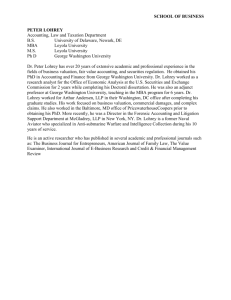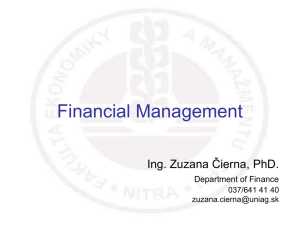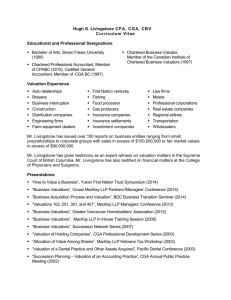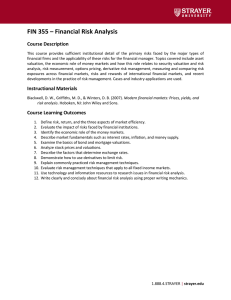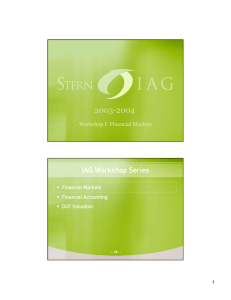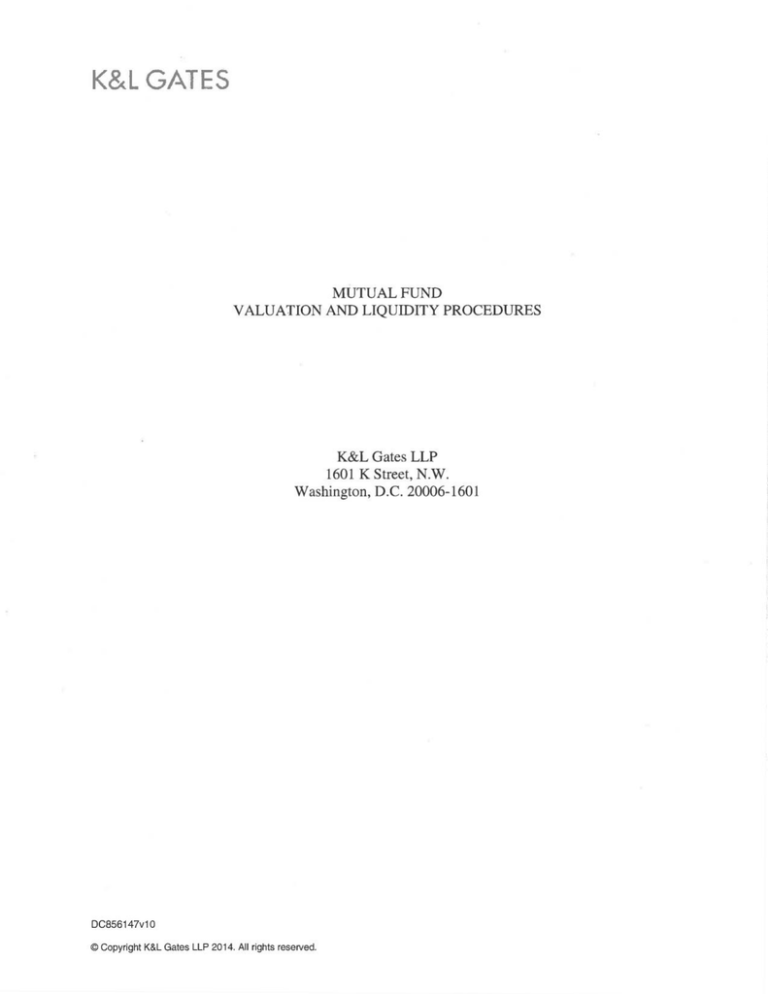
K&L GATES
MUTUAL FUND
VALUATION AND LIQUIDITY PROCEDURES
K&L Gates LLP
1601 K Street, N.W.
Washington, D.C. 20006-1601
DC856147v10
© Copyright K&L Gates LLP 2014. All rights reserved.
K&L Gates LLP
MUTUAL FUND
VALUATION AND LIQUIDITY PROCEDURES
I.
Overview — The Importance and the Complexity of Valuation Determinations
A.
Rule 22c- 1 (the "forward pricing rule") effectively requires that open-end
investment companies accurately value their portfolio securities on a daily basis.
Fund shares may be sold or redeemed only at prices based on the nextcomputed "current net asset value."
B.
Accuracy in the daily pricing of portfolio securities is essential.
If valuations are too low, purchasing shareholders will be undercharged,
redeeming shareholders will be underpaid and, if purchases exceed
redemptions, remaining shareholders will be diluted;
2.
Conversely, if valuations are too high, redeeming shareholders will be
overpaid, purchasing shareholders will be overcharged and, if redemptions
exceed new purchases, the remaining shareholders will be diluted.
C.
Valuation must be accomplished quickly, usually in the roughly 2 hour period
between the NYSE close and the NASD reporting deadline.
D.
Nevertheless, for a long time — probably for about half of the current life span of
the 1940 Act — this did not appear to be a particularly difficult or challenging
endeavor.
1.
E.
That is because investment companies originally invested almost
exclusively in exchange listed securities, for which closing market prices
were readily available directly off the exchange tickers.
This is no longer true for most funds.
Today's funds hold a multiplicity of investment products, a great many of
which are neither exchange-listed nor actively traded.
2.
As a result, valuation has become increasingly complex and challenging.
4
© Copyright K&L Gates LLP 2014. All rights reserved.
K&L Gates LLP
II.
Regulatory Framework
A.
Section 2(a)(41) and Rule 2a-4 view valuation issues in terms of a simple (and, as
we will see, somewhat misleading) dichotomy between Market Value and Fair
Value
1.
Securities for which "market quotations are readily available" are to be
valued at "market value;"
a)
b)
2.
SEC accounting release ASR 118 — which was issued in 1970 but
which, along with another ASR issued in 1969, continue to serve
as primary sources of SEC guidance on the meaning and proper
implementation of Section 2(a)(41) — effectively divided market
valuations themselves into two sub-types:
(1)
Valuations obtained through "last sales" information, such
as those that can be obtained from a securities exchange,
and
(2)
Valuations obtained through market quotations from
broker-dealers or others.
The SEC has also provided guidance as to how market valuations
may be made, calling for:
(1)
Prioritizing last quoted sales over bid and ask prices;
(2)
Utilizing quotes from the primary exchange or market on
which the security is traded; and
(3)
Using the last bid or the average of bid and asked price, but
avoiding the use of only the last asked price to determine
the value of a long position.
All other securities are to be valued at "fair value as determined in good faith
by the board of directors."
a)
Section 2(a)(4 1) and Rule 2a-4 both state this fair value requirement,
thus contemplating that fund boards will have special responsibilities
with respect to fair value determinations.
b)
In ASR 113 — the other accounting release referenced above — the
SEC stated that boards must:
" continuously review the appropriateness of any method so
determined."
© Copyright K&L Gates LLP 2014. All rights reserved.
K&L Gates LLP
c)
3.
The special responsibilities placed on fund boards for fair value
determinations, appear to arise out of a kind of objective vs. subjective
distinction:
a)
4.
In ASR 118, the SEC reiterated its "continuous review" standard and
added that, to comply with Section 2(a)(41), "it is incumbent" upon
boards "to satisfy themselves that all appropriate factors relevant to
the value of securities for which market quotations are not readily
available have been considered."
The implicit notion is that market valuations are essentially objective,
while fair valuations require more judgment (i.e., are more
subjective) and thus require more direct board involvement.
The fair value/market value distinction, however, may be more conceptual
than real, and it has been questioned. Thus, the ICI's 1997 white paper on
fund valuation and liquidity issues observed that
"it is not always clear which valuation methods would be considered
`fair value' methods, as opposed to `market value' methods under the
Act."
5.
a)
Dealer quotes, for example, may be quite subjective, with the
judgment being made by the dealer, instead of at the fund level.
b)
Matrix pricing, commonly used in the fixed income field, is often
viewed as something of a hybrid between fair and market valuation,
but in either event, it involves a fair amount of subjectivity.
Normally, however, there is a very real distinction in the identity of the
parties making the judgments in what are commonly viewed as "market"
valuations and those that are thought of as "fair" value techniques.
a)
Judgments that are made by fund management, particularly by
persons who may benefit personally if valuations increase, may
require more scrutiny than judgments made by third party market
participants who would not.
b)
This distinction, too, can be false in some circumstances. For
example, dealers who have sold thinly traded ABS tranches may
have an incentive to give pleasing quotes to their investor-customers.
c)
Nonetheless, differences in who is making the judgments inherent in
day-to-day valuations may well justify the special Board scrutiny that
LI
© Copyright K&L Gates LLP 2014. Al! rights reserved.
K&L Gates LLP
is to be accorded to what are generally viewed as "fair," rather than
"market" valuation methods.
B.
When should securities be fair valued?
ASR 118 makes clear that securities should be fair valued when market
prices, either from last trade information or market quotations, are not
"readily available."
2.
3.
a)
This is distinct from the test for liquidity, which is that the security
be "readily marketable."
b)
It is important to recognize that these two are not identical.
(1)
Securities may be readily marketable in that they can be sold
at current value within 7 days, and therefore are liquid, but
there may nevertheless be no readily available market price
for them.
(2)
The converse may also be true, especially for securities that
the SEC considers to be presumptively illiquid securities,
such as non-government IOs, and for types of derivative
contracts.
ASR 118 also reflects that fair valuations may be appropriate when the
available market quotations are not reliable. This may (but will not
necessarily) occur if:
a)
sales have been infrequent;
b)
there is a thin market for the security; or
c)
the validity of the market quotations appears questionable.
When might the validity of a market quotation be questionable? After all,
as mentioned above, market quotations are at least impliedly assumed to
be objective measures, as compared to the subjective — and therefore more
questionable — "fair value" determination.
a)
In fact, there are many possible bases for questioning the validity
of a market quotation. Three of the more important are:
(1)
Unreliability of the source of the quote. This can (but will
not necessarily) occur, for example, when a quotation is
obtained from the dealer who sold the security to the fund
and constitutes the sole source of quotations.
5
© Copyright K&L Gates LLP 2014. All rights reserved.
K&L Gates LLP
(2)
(a)
This is particularly likely if the quote is being
provided as a service but is not a "hard" quote at
which the dealer is actually prepared to purchase the
security.
(b)
Significant problems with quotes of this type arose
in connection with mortgage-backed securities in
the wake of interest rate volatility in 1994.
Staleness of a market quote.
(a)
(3)
C.
This is closely related to thinly traded securities —
quotes not obtained on the actual date of pricing, or
quotes that have remained unchanged for
suspiciously long periods of time.
Significant, post-quotation events.
(a)
This can be viewed as a kind of staleness, and it is
of particular importance for foreign securities.
(b)
It has been the source of considerable attention in
recent years.
The Effect of Significant Events
1.
2.
The question of how significant events should affect fund valuations dates
back at least to a 1981 no action letter issued to Putnam (Putnam Growth
Fund and Putnam International Equities Fund, Inc. (Feb. 23, 1981), in
which the Staff acknowledged that it was "appropriate" for a fund
investing in securities traded on the London exchange to take the
following approach to valuation:
a)
Normally, the fund would use the last sales price on the London
Exchange, even though the closing time for that exchange was 10
a.m. EST, as compared with the fund's own 4 p.m. valuation time.
b)
However, if the fund determined that a material event had occurred
that caused the 10 a.m. closing price to no longer constitute "a
reasonable estimate of the securities values" as of 4 p.m., the fund
would determine that value using fair value techniques.
This established the principle that it is appropriate to use fair value
methodologies to reflect material events that occur after the closing of the
relevant foreign markets but before the fund's normal pricing time.
0
© Copyright K&L Gates LLP 2014. All rights reserved.
K&L Gates LLP
a)
Note that this was very different than saying that it is necessary to
fair value in these situations. Also, there was no clear guidance for
indicating when such a material events determination must be
made.
3.
This highly discretionary approach came to the forefront after the 1997
Asian market turmoil. Serious questions were raised as to whether a fund
could choose not to adjust market-close quotations when there had been
significant post-closing events.
4.
In 2001, the Staff effectively resolved this part of the debate by mandating
fair valuation when a "significant event" occurs. In a letter issued to the
ICI, the Staff stated that
"If a fund determines that a significant event has occurred
since the closing of the foreign exchange or market, but
before the fund's NAY calculation, then the closing price
for that security would not be considered a "readily
available [by which, of course, the Staff meant a "reliable"]
market quotation and the fund must value the security
pursuant to a fair value pricing methodology" (emphasis
added).
a)
5.
6.
The staff also pointed out that its position "applie[d] equally to
domestic securities," if (whether by reason of an early market
close, or otherwise) there is time gap between the market close and
the time the fund prices its portfolio.
However, a regulatory mandate to fair value when there is a "significant
event" by no means ended the questions. Rather, the focus shifted to the
more nettlesome aspects of the problem — aspects that were always there —
including
a)
How should a fund determine whether an event is "significant" for
this purpose? and
b)
What should be the basis for the fair valuation that would need to
replace the closing prices?
On these questions, the Staff was less definitive.
a)
On the one hand, it articulated a new (or at least newly
highlighted) duty: funds must "continuously monitor" for events
that might necessitate fair value pricing — i.e., "significant" events.
7
© Copyright K&L Gates LLP 2014. All rights reserved.
K&L Gates LLP
b)
D.
III.
On the other hand, however, the Staff did not establish specific
criteria for determining when a significant event had occurred.
Rather, it advised that funds needed to establish such criteria,
noting that it believed that the same factors that apply to fair
valuation generally should apply to this determination.
Bases for Making Fair Value Determinations
1.
So how should fair value determinations be made?
2.
The SEC has characterized "fair value" as "the amount which the owner
might reasonably expect to receive upon [a] current sale."
3.
There is no single correct way to determine fair value.
4.
The ASRs suggest several methodologies and factors that may be used,
including:
a)
multiples of earnings;
b)
discount from market of similar, freely traded securities;
c)
for debt instruments, yield to maturity;
d)
fundamental analytical data; and
e)
combinations of the foregoing.
ASC Topic 820 (Previously FAS 157)
A.
It is enlightening to consider all of this SEC guidance in the context of Financial
Accounting Standards Board's statement on Fair Value Measures, ASC 820. 1
B.
Eliminating the Market Value/Fair Value Dichotomy
1.
Notably, ASC 820 does not reflect the same dichotomy between "market"
and "fair" valuations that exists under the 1940 Act and the various SEC
pronouncements.
a)
Instead, ASC 820 makes clear that market quotations — whether
obtained from an exchange closing price or from dealer quotations
— are merely means ("inputs") for determining the fair value of an
asset.
' ASC 820 initially was issued as FAS 157 in September, 2006 and became effective for
financial statements issued for fiscal years beginning after November 15, 2007.
© Copyright K&L Gates LLP 2014. All rights reserved.
K&L Gates LLP
b)
2.
C.
In the long run, the absence of that dichotomy under GAAP may
be significant in assessing the relative roles and responsibilities of
fund boards with respect to the various means used in the value
process.
ASC 820 establishes a somewhat different dichotomy, discussed below.
This dichotomy is between "observable" and "unobservable" inputs, and
the Statement presents a hierarchy of these inputs that is substantially
similar to what is called for under existing SEC guidance.
Techniques, Approaches and Inputs
ASC 820 articulates three types of valuation "approaches" — market,
income and cost — that may be chosen as appropriate for valuing particular
assets.
a)
2.
The "market" approach is described as the use of "prices and other
relevant information generated by market transactions involving identical
or comparable (that is, similar) assets, liabilities, or a group of assets and
liabilities."
a)
3.
The Statement then refers to various valuation "techniques" that
are consistent with, and that serve to describe, these approaches.
Matrix pricing is described as a valuation "technique" that is
consistent with the market approach to fair valuing assets.
The "income" approach is described as "convert[ing] future amounts, such
as from cash flows or income and expenses, to a single present
(discounted) amount."
a)
Present value techniques and option pricing models, such as the
Black-Scholes-Merton formula, are described as techniques that
are used under this approach.
4.
The "cost" approach is based on current replacement cost ("the amount
that would currently be required to replace the service capacity of an
asset") and utilizes techniques that seem generally best suited for tangible
assets, rather than the financial instruments with which funds are
concerned.
5.
While the market approach appears to be the most appropriate valuation
"approach" for most of the financial assets held by funds — i.e., stocks and
bonds — the income approach might be thought to be appropriate to some
derivative assets.
0
© Copyright K&L Gates LLP 2014. All rights reserved.
K&L Gates LLP
6.
a)
However, the Section 2(a)(41) and Rule 2a-4 requirements that
priority be given to market valuations may present obstacles for
funds that might wish to apply the income approach to valuing
such assets.
b)
ASC 820 recognizes that in some cases multiple valuation
techniques may be appropriate for use in connection with a given
valuation approach. However, while a change in technique may be
appropriate as long as it yields a value that is "equally or more
representative of the fair value," techniques are to be consistently
applied.
The heart of ASC 820 is a statement of a hierarchy of valuation "inputs"
that are to be used in order to apply the chosen valuation approach and
technique.
a)
"Inputs" are described as being "the assumptions that market
participants would use in pricing", including assumptions about
risk.
b)
Inputs are divided into two categories: observable and
unobservable.
c)
(1)
"Observable" inputs are inputs that are based on market
data obtained from sources independent of the reporting
entity.
(2)
"Unobservable" inputs are inputs that reflect the reporting
entity's own assumptions as to how market participants
would approach pricing.
(a)
These are to be based on "the best information
available in the circumstances."
(b)
But the key distinction is that they are not from
independent, third party sources.
The Statement requires that valuation techniques "maximize the
use of relevant observable inputs and minimize the use of
unobservable inputs."
(1)
In other words, ASC 820, like the 1940 Act and the SEC's
guidance, prefers third party market data to internally
generated calculations.
10
© Copyright K&L Gates LLP 2014. All rights reserved.
K&L Gates LLP
(2)
D.
But this is not quite the same as a distinction between
"market" values and "fair" values.
The Fair Value Hierarchy
1.
ASC 820 describes three "levels" of hierarchy of fair value measurement.
2.
Level 1 — the highest level of inputs — comprises unadjusted quoted prices
in active markets for identical assets.
a)
This is to be given the highest priority.
b)
However, ASC 820 allows for adjustment in certain circumstance,
including where there have been "significant events."
c)
(1)
As under the SEC's 2001 letter, ASC 820 states that
reporting entities should "establish and consistently apply a
policy for identifying those events that might affect fair
value measurements."
(2)
When adjustments are made by reason of such events,
however, the input ceases to be "Level 1."
ASC 820 also makes clear that a quoted price should not be
adjusted "even if a market's normal daily trading volume is not
sufficient to absorb the quantity held and placing orders to sell the
position in a single transaction might affect the quoted price."
(1)
3.
This is consistent with the long standing SEC position that
liquidity determinations should be made by reference to the
ability to dispose of a normal trading unit of securities, not
the ability to dispose of the entirety of a large block of
shares. (Inv. Co. Rel. 19399 (April 7, 1993))
Level 2 inputs are inputs other than quoted prices included in Level 1 that
are "observable" either directly or indirectly. These include (seemingly,
but not clearly, in order of preferability):
a)
Quoted prices for similar assets in active markets — e.g., matrix
pricing;
b)
Quoted prices for either identical or similar assets in markets that
are not active;
11
© Copyright K&L Gates LLP 2014. All rights reserved.
K&L Gates LLP
4.
c)
Inputs other than quoted prices that are observable — e.g., interest
rates and yield curves that are observable at commonly quoted
intervals, implied volatilities, and credit risks; and
d)
Inputs that are derived principally from or corroborated by
observable market data by correlation or other means. These are
called "market corroborated inputs."
Level 3 inputs are those that are unobservable.
a)
5.
E.
This is in effect an "all other" category that seems to equate to
what most people would have considered "fair valuing" under the
traditional SEC guidance.
The difference in the categories used by ASC 820, as compared to those
used in the SEC guidance is revealing. It emphasizes the extent to which
pricing data, if not the valuation itself, is primarily objective and comes
from third party sources.
Disclosure
1.
The aspect of ASC 820 that may have the most significant effect on funds
is its requirement regarding disclosure.
2.
ASC 820 requires that entities disclose the following information for each
annual and interim financial reporting period:
a)
The fair values of their assets;
b)
The "level" within the fair value hierarchy in which the assets fell
— in other words:
(1)
c)
if the entity reported total assets fair valued at $100 million,
what portion was valued using Level 1 inputs (e.g., $75
million was valued using quoted prices in active markets),
what portion using Level 2 inputs (e.g., $20 million was
valued using "other observable inputs") and what portion
using Level 3 inputs (e.g., $5 million using unobservable
inputs).
For the assets valued using Level 3 (unobservable) inputs, a
reconciliation showing beginning and ending balances broken
down to show gains and losses, purchases and sales and transfers
in and out of the Level 3 input category.
12
© Copyright K&L Gates LLP 2014. All rights reserved.
K&L Gates LLP
ASC 820 also requires that entities report for the reporting period the
valuation techniques used to measure fair value and a discussion of any
changes in those techniques during the period.
IV.
Delegation and Controls
A.
Despite the emphasis on board responsibility, delegation of day-to-day
responsibility for fair valuation determinations is both necessary and
contemplated by SEC guidelines.
ASR 113 indicated that fund boards could discharge their responsibility for
fair valuations by determining "the method" of valuing each restricted
security, while allowing others to perform the "actual calculations" pursuant
to the board's directions.
2.
ASR 118 expanded on this, stating that boards may
"appoint persons to assist them in the determination of value and to
make the actual calculations...."
3.
B.
C.
Thus, the assistance that boards can obtain encompasses more than the
ministerial job of making calculations. It extends to making the
determinations as to the appropriate fair value methodology.
Impracticality of Direct Board Determinations and "Continuous" Board Review
of Day-to-Day Decisions
1.
As a practical matter, it is not feasible for boards to have more than
minimal involvement in the day to day valuation process.
2.
Also, such direct involvement is not the normal manner in which boards
function.
The appropriate role for the Board is to act as the highest level of oversight in a
multi-tiered system of supervision and controls. This entails:
Board approval and periodic review and (if necessary) adjustment of
valuation procedures.
a)
These procedures should be written and should establish the basis
on which valuation data will be generated, reviewed and adjusted.
b)
Normally, these procedures will be developed by fund
management but should be reviewed and approved by the board.
13
© Copyright K&L Gates LLP 2014. All rights reserved.
K&L Gates LLP
D.
2.
Establishment, as a part of the valuation procedures, of a system of
supervision and controls.
3.
Board receipt and review of periodic reports as to the functioning of the
valuation process, including reports of any material pricing problems,
errors and corrections.
Effective controls are central to the discharge of the board's responsibilities.
1.
Most enforcement cases involving valuation issues (e.g., Rogge and
Mitchell Hutchins) have been heavily influenced by an absence of effective
controls over the pricing process.
2.
E.
Others (e.g., Parnassus) have highlighted the importance of documenting
that the board or its designees have considered the relevant factors and
have consistently applied a reasonable fair valuation procedure.
The key elements of an effective control system include:
1.
Identification of acceptable sources of regular pricing information,
preferably from third parties, and verifying that those sources have
internal controls for verifying the validity of the information they provide.
a)
Whenever possible, the basis on which the third party derives its
prices should be documented.
b)
Some complexes insist that quoting dealers stand ready to buy the
securities they price at the quoted price.
(1)
c)
When prices are generated internally, there should be special
procedures ensuring supervisory review of the methodologies used.
(1)
2.
However, most dealers resist this and at least the smaller
complexes generally do not have the market power to
insist.
Portfolio managers are often an important part of the
process of challenging third party prices or recommending
methodologies for fair valuing complex securities, but their
recommendations should be promptly reviewed and, where
feasible pre-approved, by supervisory personnel.
Review and supervision by the primary pricing group — generally fund
accounting or administrators or the fund's custodian. This may include:
14
© Copyright K&L Gates LLP 2014. All rights reserved.
K&L Gates LLP
a)
b)
c)
Periodic cross-checking of pricing service information and dealer
quotes against information from alternative sources.
(1)
In particular, prices derived through matrix pricing and
analytical techniques should be checked.
(2)
Frequency of cross checks may vary depending on
circumstances, but commonly ranges between bi-weekly
and quarterly.
Use automated flagging systems to detect potential problems.
Typical flags include:
(1)
no price reports;
(2)
tolerance tests — i.e., determining whether a change in price
is outside of a pre-determined range;
(3)
unchanged or stale price reports;
(4)
comparisons of actual trades to most recent valuations; and
(5)
identification of corporate actions.
Price review by investment personnel.
(1)
3.
4.
While portfolio managers generally should not be able to
unilaterally override third party prices, they can be an
invaluable sources for challenges which can be reviewed by
supervisory personnel.
Oversight of the primary pricing group by a special valuation committee
or other supervisory personnel within fund management. Functions may
include:
a)
approval and regular review of pricing methodologies;
b)
receive periodic reports from, and monitor implementation of
controls by, primary pricing groups and of problems and "flags"
noted;
c)
periodic review of adequacy of valuation procedures; and
d)
preparation of reports to the board.
Board review of periodic reports.
15
© Copyright K&L Gates LLP 2014. All rights reserved.
K&L Gates LLP
5.
V.
Independent auditors' annual review of accuracy of fund NAV and pricing.
Correction of Pricing Errors
A.
Traditionally, the SEC's view was that pricing errors affecting fund NAV by 1 ¢ or
more per share were material and required correction.
This means a real penny per share, not a number that rounds up to a penny
per share.
B.
Since 1995, however, the SEC staff has informally accepted the appropriateness
of a more complex system under which
1,
errors of less than 1 ¢ per share are immaterial and do not require
corrective action
2.
errors of 1¢ or more per share require financial adjustments in favor of the
fund, but no payments to affected shareholders or reprocessing of
shareholder accounts is required unless the errors amount to at least 'h of
1% of per share NAV.
a)
C.
VI.
The staff also has informally accepted a de minimis standard of
$10.00 per shareholder account before compensation is made to
shareholders.
Many fund boards have passed resolutions formalizing the approach to error
correction that they expect to be followed.
Liquidity Procedures
A.
B.
Regulatory requirements
1.
SEC policies require that no more than 15% of an open-end fund's net
assets (other than for money market funds) be illiquid.
2.
A security normally is considered illiquid if it cannot be "sold or disposed
of in the ordinary course of business within 7 days at approximately the
value" at which it is being carried by the fund.
Establishing responsibility for monitoring and making liquidity determinations
1.
Funds need to establish guidelines for identifying illiquid portfolio
securities at or prior to the time that they are purchased and for monitoring
liquidity (or illiquidity) thereafter.
16
© Copyright K&L Gates LLP 2014. All rights reserved.
K&L Gates LLP
a)
Unlike valuation determinations, the initial liquidity determination
frequently is made by the portfolio manager.
b)
Managers should identify events that may change the liquid or
illiquid status of particular securities and report those events to
identified supervisory personnel.
(1)
C.
Most funds do not establish regular monitoring of securities
to verify their liquidity.
Procedures for determining that presumptively illiquid securities are liquid
1.
The SEC has indicated that certain types of securities are presumed to be
illiquid but that the presumption may be overcome if appropriate findings
are made pursuant to procedures approved by the fund's board.
2.
Presumptively illiquid securities include:
3.
a)
Rule 144A securities
b)
Municipal lease obligations
c)
Fixed rate government IOs and POs
d)
Section 4(2) commercial paper
Factors used to overcome the presumption of illiquidity include:
a)
Frequency of trades or quotes;
b)
The number of dealers or others willing to purchase the security;
c)
dealer undertakings to make a market in the security; and
d)
the nature of the marketplace (i.e., mechanics of transfer; available
methods of soliciting offers, etc.).
17
© Copyright K&L Gates LLP 2014. All rights reserved.

